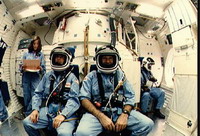Kennedy Space Center launches shuttle simulator
Rumbles and roars are heard as the space shuttle gets to blastoff speed. Minutes later, the vehicle pitches forward suddenly at engine cutoff, giving a serene view of Earth.

Kennedy Space Center's shuttle launch simulator is as close to outer space as most people will ever get. But it really is comparable, say those who know.
Nearly 40 astronauts took the maiden voyage Friday of the simulator for visitors to the NASA center. The Shuttle Launch Experience is the agency's first venture into the theme park-like ride business, a $60 million (44.64 million EUR) attraction simulating a blastoff from the same Atlantic Coast spot as real shuttles.
"It's pretty realistic with all the shakes and rattles and vibration," said John Young, commander of the first space shuttle mission and one of the astronauts who took the inaugural ride.
A handful of space veterans were consulted to ensure everything is as realistic as possible, even using NASA's confusing code of acronyms to explain the liftoff.
Space center officials devised the idea seven years ago, searching for a new way to interest people (particularly children) in shuttles. The simulator is more National Geographic than Space Mountain, spending a lot of time on science and education. But there is a thrill-ride feel as the vehicle shakes and jolts.
The simulator building at Kennedy's visitor center is designed to look like the real ones by the launch pads a few miles away. Visitors enter though a steel gantry and receive a mission "briefing" from Hall of Fame astronaut Charlie Bolden on three elaborate projection screens in a circular room.
Steam billows out of the floor and the room shakes as Bolden explains the mission process. The doors open and the computer announces, "Trainees report to simulator."
The floor leading up to the shuttle is flat, but made to look like pebbled industrial steel. Those with health problems are advised not to ride.
Visitors are strapped in and tilted back 90 degrees, the same position in which astronauts wait two hours before launch. The blastoff rattles the vehicle, and the simulator seems like it's going so fast it pulls back skin on the cheeks.
Young and shuttle pilot Bob Crippen said some things were actually overemphasized - particularly the noise. It's not as loud in real life, surprisingly, and does not sound exactly the same.
"You're sitting in there in the cockpit, you're wearing a helmet and you're a long ways from where the noise is coming from," Young said. "There's a clunk when you separate from the solid rocket boosters, there's a click when you separate the external tank."
The exit is a long, dark circle with twinkling stars simulating outer space on the ceiling and a bright picture of earth at the bottom. After that is a gift shop.
None of the astronauts seemed too interested in the T-shirts, shot glasses, key chains and astronaut ice cream, but they all seemed thrilled with the ride.
It was a big lot of them to be somewhere all at once - balding, with graying hair and a few extra pounds (kilos) filling their blue flight suits these days. Decades ago they docked with the Russians, rescued satellites and walked on the moon.
They still remember vividly what it felt like, and the simulator is the closest they will ever get to it again, too.
"You obviously can't get to three G's in here, but they do make the initial feelings of each of the events feel very realistic," said Roy Bridges, former shuttle pilot.
Subscribe to Pravda.Ru Telegram channel, Facebook, RSS!


